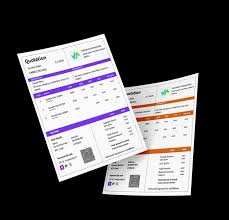Introduction to Send Quotations
In the dynamic landscape of business, the art of sending quotations plays a pivotal role in establishing professionalism and fostering successful transactions. Professional quotations serve as the initial gateway to communication between businesses and clients, encapsulating the essence of a proposed deal. The importance of these documents cannot be overstated, as they lay the foundation for a clear understanding of services or products offered.
The impact of effective quotation practices extends beyond mere transactional documentation. It influences the perception of the business and reflects a commitment to transparency, reliability, and attention to detail. An adeptly crafted quotation not only communicates pricing but also communicates the value proposition, showcasing why the offered solution is the ideal fit for the client’s needs.
In today’s digital age, businesses are increasingly leveraging technology to streamline and enhance their quotation management processes. Various tools and software solutions are available to simplify the creation, customization, and tracking of quotations. These technologies not only save time but also contribute to accuracy and consistency, ensuring that each quotation reflects the brand’s professionalism.
As businesses navigate through a competitive market, the adoption of technology becomes crucial for maintaining efficiency and competitiveness. Whether it’s through dedicated quotation management software or integrated Customer Relationship Management (CRM) systems, technology empowers businesses to manage quotations seamlessly.
In essence, a well-structured introduction to sending quotations emphasizes the strategic role they play in business interactions. It underlines the importance of professionalism, showcases the impact of effective practices, and underscores the value of incorporating technology for efficient quotation management. This sets the stage for the subsequent sections, delving deeper into the intricacies of crafting compelling quotations and optimizing processes for enhanced business outcomes.
The Art of Crafting Compelling Quotations
Crafting compelling quotations is both an art and a science, requiring a deep understanding of customer needs, impeccable clarity, and persuasive language to make a lasting impact.
- Understanding Customer Needs and Preferences: Effective quotations begin with a thorough understanding of the customer’s requirements. Businesses must conduct comprehensive research and analysis to discern the pain points, preferences, and objectives of the prospective client. By aligning the quotation with the customer’s specific needs, businesses can demonstrate empathy and relevance, increasing the likelihood of acceptance.
- Clarity and Transparency in Quotation Details: Clarity is paramount when presenting quotation details. Each component, from pricing to deliverables, must be clearly outlined and transparently communicated to the client. Ambiguity or confusion in the quotation can lead to distrust and hesitation on the part of the customer. By providing a comprehensive breakdown of costs, timelines, and specifications, businesses instill confidence and credibility, fostering a positive perception of the proposed deal.
- Incorporating Persuasive Language for Impact: Language is a powerful tool in persuasion, and quotations are no exception. Businesses must leverage persuasive language to evoke emotion, convey value, and compel action. This includes highlighting the unique selling points of the product or service, emphasizing benefits over features, and framing the proposal in a compelling narrative. By tapping into the psychological triggers that drive decision-making, businesses can make their quotations more persuasive and compelling.
In essence, the art of crafting compelling quotations revolves around understanding the customer, communicating with clarity and transparency, and leveraging persuasive language to make a lasting impact. Businesses that master this art can effectively differentiate themselves from competitors, build trust with clients, and ultimately drive conversions and sales.

Utilizing Technology for Quotation Automation
Embracing technology for quotation management is a strategic move that can revolutionize and streamline business processes. Here, we delve into the world of Quotation Management Software (QMS) and explore how businesses can leverage automation to enhance their quotation processes.
Introduction to Quotation Management Software (QMS): Quotation Management Software is a specialized tool designed to simplify and optimize the end-to-end quotation process. These platforms typically offer features such as template creation, pricing management, and document tracking. Introducing businesses to QMS opens the door to a more organized, efficient, and error-free quotation workflow.
Streamlining Quotation Processes with Automation: Automation is at the heart of modern business optimization, and the quotation process is no exception. QMS allows businesses to automate repetitive tasks, such as generating and sending quotations, updating pricing information, and tracking responses. By automating these manual processes, businesses can significantly reduce the risk of errors, improve efficiency, and free up valuable time for teams to focus on strategic tasks.
Integrating Quotation Tools with CRM Systems: The synergy between Quotation Management Software and Customer Relationship Management (CRM) systems is a game-changer. Integration ensures seamless data flow between the two, providing a comprehensive view of customer interactions, preferences, and transaction history. This holistic approach empowers businesses to create personalized and targeted quotations, enhancing customer engagement and increasing the likelihood of successful conversions.
In conclusion, the utilization of technology, specifically Quotation Management Software, has the potential to revolutionize how businesses manage their quotation processes. From simplifying tasks to improving accuracy and integrating with CRM systems, these tools offer a comprehensive solution for businesses aiming to enhance their efficiency and deliver compelling quotations to their clients.
Key Components of an Effective Quotation

Crafting an effective quotation requires careful consideration of several key components to ensure clarity, transparency, and persuasiveness. Let’s explore these components in detail:
- Itemized Pricing and Breakdown: Transparency in pricing is essential for building trust with clients. An effective quotation should include a detailed breakdown of costs, clearly outlining the price of each product or service offered. Itemizing pricing allows clients to understand what they are paying for and helps to avoid misunderstandings or disputes later on. Additionally, providing optional extras or add-ons with their associated costs gives clients the flexibility to tailor the quotation to their needs.
- Terms and Conditions for Clarity: Including clear and concise terms and conditions in the quotation is crucial for setting expectations and avoiding misunderstandings. These terms should cover important aspects such as payment terms, delivery timelines, warranties, and any applicable taxes or fees. Clearly outlining the terms and conditions ensures that both parties are on the same page and helps to mitigate risks or disputes down the line. It’s also advisable to include information on how changes to the quotation or contract will be handled to maintain transparency and avoid confusion.
- Personalization and Customization Techniques: Personalizing the quotation to the specific needs and preferences of the client can significantly enhance its effectiveness. This can be achieved by addressing the client by name, referencing previous interactions or discussions, and tailoring the content to highlight how your products or services meet their unique requirements. Additionally, incorporating customization techniques such as offering different package options or providing personalized recommendations based on the client’s preferences can help to increase the likelihood of a positive response.
In conclusion, an effective quotation should include itemized pricing and breakdowns, clear terms and conditions, and personalized content tailored to the client’s needs. By paying attention to these key components and ensuring clarity, transparency, and relevance, businesses can increase their chances of successfully converting leads into opportunities.
Optimizing Quotations for Various Business Scenarios
Creating optimized quotations involves tailoring the approach based on the specific nature of the business scenario. Let’s delve into the nuances of optimizing quotations for various scenarios:
- Quoting for Product Sales: When providing quotations for product sales, it’s crucial to highlight the unique selling points of the products. Include detailed descriptions, specifications, and any special features that differentiate your products from competitors. Clearly outline the pricing structure, including any discounts, bulk purchase options, or promotions. Additionally, consider incorporating visuals such as images or product catalogs to enhance the client’s understanding and showcase the value proposition.
- Service-Based Quotations and Consultancy: For service-based businesses or consultancy services, the focus should shift towards clearly defining the scope of services. Break down the services offered, outlining the specific tasks or deliverables included in the quotation. Provide a detailed timeline for project completion and highlight the expertise and qualifications of the team involved. Offering a free consultation or initial assessment can add value and demonstrate your commitment to understanding the client’s needs.
- B2B and B2C Quotation Strategies: Tailoring your quotation strategy based on whether you are dealing with a business (B2B) or an individual consumer (B2C) is essential. In B2B scenarios, emphasize the long-term benefits, cost savings, and potential for collaboration. Provide flexible payment terms and customization options to accommodate the unique requirements of business clients. For B2C, focus on addressing individual needs, emphasizing convenience, and creating a compelling narrative around how your products or services enhance the customer’s lifestyle.
In essence, optimizing quotations for different scenarios involves understanding the specific needs and preferences of the target audience. By customizing the approach based on whether you’re dealing with products, services, businesses, or individual consumers, you can enhance the relevance and effectiveness of your quotations, ultimately increasing the likelihood of lead conversion.
Strategies for Improving Quotation Approval Rates

Boosting quotation approval rates requires a strategic approach that encompasses transparency, incentives, and effective follow-up techniques. Let’s explore these strategies in detail:
- Building Trust through Transparent Pricing: Transparency is key to establishing trust with potential clients. Clearly articulate your pricing structure, breaking down costs and explaining the value they receive. Avoid hidden fees and provide detailed itemization to showcase the fairness and clarity of your pricing. Additionally, consider offering different pricing tiers or customizable options to cater to various budget preferences.
- Incentivizing Quick Decision-Making: Encourage prompt decision-making by incorporating incentives into your quotations. Offer limited-time discounts or exclusive promotions for clients who accept the quotation within a specified timeframe. Highlighting the benefits of early commitment, such as priority service or additional perks, creates a sense of urgency and motivates clients to make timely decisions.
- Follow-Up Techniques for Quotation Conversion: Effective follow-up is crucial in moving potential clients towards approval. Implement a systematic follow-up process that includes personalized communication. Use automation tools to schedule follow-up emails or calls at strategic intervals. In your follow-ups, address any concerns or queries the client may have, and offer additional information or clarification if needed. Tailor your follow-up approach based on the client’s level of engagement and responsiveness.
Implementing these strategies collectively enhances the likelihood of improving quotation approval rates. By fostering trust, providing incentives for quick decisions, and implementing proactive follow-up techniques, you create a conducive environment for clients to move from considering the quotation to approving it. This not only accelerates the sales process but also contributes to the overall satisfaction and positive perception of your business.
Overcoming Challenges in Quotation Management
Navigating the challenges in quotation management requires a nuanced approach to handle negotiations, address concerns, and manage revisions effectively.
- Dealing with Price Negotiations: Price negotiations are a common aspect of the quotation process. Approach negotiations as an opportunity for collaboration rather than confrontation. Understand the client’s budget constraints and be prepared to offer flexible solutions. Clearly communicate the value of your products or services to justify pricing. If possible, provide options or alternatives that accommodate their budget while maintaining profitability for your business.
- Addressing Customer Concerns and Queries: Proactively addressing customer concerns and queries is essential for maintaining transparency and trust. Create a comprehensive FAQ section in your quotations that anticipates and answers common questions. Additionally, encourage clients to reach out with any specific concerns they may have. Respond promptly and provide detailed explanations, ensuring that clients feel heard and valued.
- Managing Quotation Revisions and Updates: Quotation revisions are often necessary as project details evolve or client requirements change. Implement a systematic approach to managing revisions, ensuring that updates are clearly communicated. Utilize quotation management software that allows for easy tracking of changes and version history. Clearly outline the modifications made in each revision and provide a summary of the impact on pricing or terms. This transparency ensures that both parties are on the same page throughout the negotiation process.
By effectively handling price negotiations, addressing customer concerns, and managing revisions with transparency, businesses can overcome common challenges in quotation management. This not only streamlines the negotiation process but also strengthens client relationships and contributes to overall customer satisfaction.
Measuring Success in Quotation Practices: Metrics, Feedback, and Continuous Improvement

In the competitive world of business, creating effective quotations is crucial for winning new clients and driving project success. However, simply providing quotations is not enough. It’s essential to measure their effectiveness and continuously refine your approach to maximize their impact. This section delves into key metrics, customer feedback, and strategies for measuring success in your quotation practices.
Analyzing Conversion Rates:
Conversion rates play a vital role in assessing the effectiveness of your quotations. Here are key metrics to consider:
- Quote-to-closure rate: This measures the percentage of quotations that convert into actual sales or projects. A higher rate indicates a strong correlation between your quotations and winning business.
- Lead-to-quote conversion rate: This metric tracks the percentage of leads who receive a quote and move forward in the sales process. Analyzing this rate can reveal opportunities to improve the effectiveness of your early interactions with potential clients.
- Acceptance rate: This metric represents the percentage of clients who accept your quoted price. A low acceptance rate might suggest room for better understanding client needs or adjusting your pricing strategies.
Customer Feedback and Testimonials:
While conversion rates offer valuable insights, it’s equally important to gather feedback directly from your customers. This qualitative data provides deeper understanding of what resonates with them and identifies areas for improvement. Here are ways to gather customer feedback:
- Post-quote surveys: Send surveys after delivering the quote to gather feedback on its clarity, comprehensiveness, and pricing competitiveness.
- Client testimonials: Encourage satisfied clients to share positive testimonials about their experience with your quotation process, showcasing its value to potential customers.
- Direct communication: Encourage open communication with clients throughout the sales process and address any concerns or questions they may have regarding the quote. By actively listening to customer feedback, you gain valuable insights into their expectations and can refine your quotation practices to better align with their needs.
Continuous Improvement in Quotation Strategies:
Based on the data and feedback gathered, continuously improve your quotation strategies through the following approaches:
- Analyze trends and identify areas for improvement: Analyze conversion rates, customer feedback, and internal data over time to identify trends and areas where your quotation practices can be strengthened.
- Refine your quotation content: Ensure your quotations are clear, concise, and visually appealing. Highlight key information like project scope, deliverables, timeline, and pricing in an easy-to-understand format.
- Personalize your quotations: Tailor your quotations to each specific client’s needs and requirements, demonstrating your understanding of their project and business objectives.
- Utilize appropriate quotation tools: Consider using quotation software or templates to streamline the creation process, ensure consistency, and improve efficiency.
- Invest in sales training: Equip your sales team with effective communication skills and negotiation techniques to effectively present and discuss quotations with potential clients.
By measuring and analyzing your quotation practices, gathering feedback, and continuously refining your approach, you can ensure your quotations effectively communicate the value you offer, resonate with potential customers, and ultimately drive increased conversion rates and business growth.
Remember, successful quotations are not just about presenting prices; they are about building trust, demonstrating expertise, and clearly communicating the value you deliver. By prioritizing these elements and using data-driven insights to continuously improve your approach, you can transform your quotations into powerful tools for winning new business and achieving your sales objectives.
Future Trends in Quotation Management: Embracing Innovation for Enhanced Efficiency and Effectiveness

The landscape of quotation management is constantly evolving, with innovative technologies emerging to enhance efficiency, accuracy, and effectiveness. This section explores two promising trends that are shaping the future of quotation management: artificial intelligence (AI) and blockchain technology.
Artificial Intelligence in Quotation Personalization:
AI is poised to revolutionize quotation personalization by leveraging machine learning and data analysis. Here are some ways AI can be utilized:
- Predictive analytics: AI algorithms can analyze historical data and customer information to predict future needs and preferences. This allows for tailoring quotations to individual client requirements, increasing their relevance and perceived value.
- Real-time pricing and optimization: AI can analyze dynamic market conditions and resource availability to offer clients real-time pricing options and optimized quotes that are both competitive and profitable for your business.
- Automated content generation: AI can assist in generating personalized quotation content based on specific project requirements and client data, saving time and ensuring consistency in your communication.
By leveraging AI, you can personalize your quotations to a deeper level, respond to client needs more effectively, and stand out from the competition in a crowded marketplace.
Blockchain for Enhanced Security and Transparency:
Blockchain technology offers a secure and transparent way to manage data exchange, potentially impacting quotation management in these ways:
- Secure and tamper-proof quotations: Blockchain can create immutable and verifiable records of quotations, ensuring their authenticity and preventing unauthorized modifications, fostering trust and transparency with clients.
- Streamlined collaboration: Blockchain can facilitate secure collaboration between different departments or teams involved in the quotation process, enabling real-time document sharing and version control.
- Enhanced auditability: Blockchain’s inherent transparency allows for easier audit trails and simplifies compliance with data privacy regulations like GDPR or CCPA.
By implementing blockchain technology, you can enhance the security and transparency of your quotation processes, build trust with clients, and improve the overall efficiency and auditability of your operations.
Additional future trends in quotation management include:
- Self-service quotation portals: Empowering clients to generate personalized quotes through user-friendly online portals.
- Integration with CRM and ERP systems: Streamlining data exchange and automating workflows between quotation management systems and other critical business software.
- Big data analytics: Utilizing data from various sources to gain deeper insights into customer behavior, pricing trends, and market dynamics, allowing for more data-driven decision making in your quotation practices.
These advancements, along with the increasing adoption of AI and blockchain, promise to transform the way businesses manage quotations. By embracing these trends and continuously adapting your approach, you can gain a competitive edge and maximize the effectiveness of your quotations in the ever-evolving business landscape.
Conclusion
In the intricate dance of business transactions, mastering the art of quotation excellence is the key to unlocking doors of opportunity and fostering lasting partnerships. Crafting compelling and transparent quotations goes beyond a mere exchange of numbers; it’s a strategic communication that resonates with clients and establishes trust. As we conclude this exploration into the world of sending quotations, it’s evident that attention to detail, clarity in communication, and leveraging technology are paramount.
A well-crafted quotation not only outlines costs but also tells a story of value, reliability, and commitment. It serves as a business’s silent ambassador, speaking volumes about professionalism and dedication to customer satisfaction. Whether navigating product sales, service-oriented ventures, or complex B2B negotiations, the principles remain the same: understand your audience, communicate with transparency, and employ technology to streamline processes.
The optimization of quotations doesn’t stop at the document itself; it extends to the entire journey — from crafting to negotiation, approval, and beyond. By implementing best practices, overcoming challenges, and adapting to diverse business scenarios, organizations can elevate their quotation game. This mastery is not just about closing deals; it’s about forging connections, building trust, and paving the way for sustained business growth.
As businesses continue to evolve in a dynamic market landscape, the ability to send quotations that resonate and convert is a skill that will set industry leaders apart. So, let each quotation be a testament to your commitment to excellence — a powerful tool in the arsenal for navigating the complexities of modern commerce.









